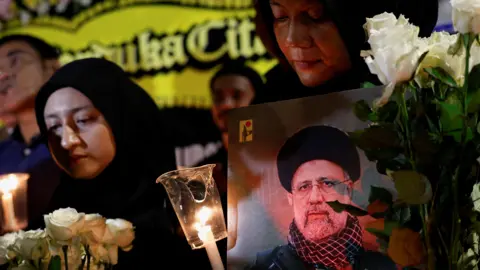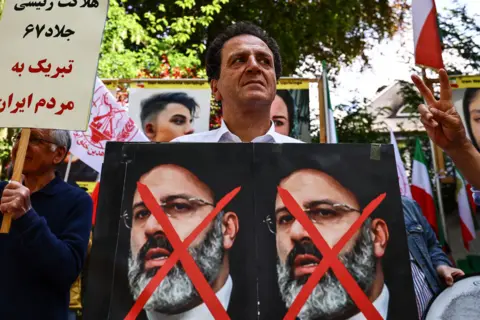Raisi's death leaves Iranians with mixed feelings
 Reuters
ReutersEbrahim Raisi was loved by hardliners of the Islamic Republic of Iran for his loyalty and obedience to Iran’s supreme leader.
However, he was equally hated by many Iranians for his role in the mass execution of political prisoners in the 1980s, and his more than four-decade involvement in the security and judicial systems which suppress opponents and critics of the Islamic regime.
In the 1980s, Raisi was appointed by Ayatollah Ruhollah Khomeini, the founder of the Islamic Republic of Iran, to be a member of a committee that dealt with political prisoners.
This committee, later known as the "death committee", carried out trials that resulted in hundreds of death sentences.
More than 5,000 political prisoners were executed. Their families never found out how, when, or where they were buried.
Some relatives of those executed after the "death committee" trials have expressed frustration and sadness at Raisi's sudden death. They long held onto hope that he would one day face justice in an international court for crimes against humanity.
Now this will never be possible.
His supporters would point to Iranian state media's depiction of Raisi as the president of the unprivileged and poor.
When he first became president in 2021, Raisi travelled to many parts of Iran, promising to build millions of affordable houses, reduce inflation and fight corruption.
Under his leadership, there was some reform in processing a backlog of court cases, and relatives of some officials were arrested for corruption and bribery.
Despite this, the economic situation in Iran worsened and hardliners imposed harsher restrictions on freedom of speech, as well as a stricter dress code on women.
 EPA
EPAIn 2022, 22-year-old Mahsa Amini died three days after she was detained by morality police in the capital for allegedly violating Iran's strict rules requiring women to cover their hair with a hijab, or headscarf.
Her death sparked major nationwide protests. Witnesses said Masha Amini was beaten while in custody, but authorities denied she was mistreated and instead blamed "sudden heart failure" for her death.
Protesters directed most of their ire towards Iran’s Supreme Leader, not President Raisi, as opponents and critics saw the president purely as a puppet, installed through an engineered election.
Many believe Raisi failed to improve the lives of Iranian people. The value of the Iranian currency has dropped sharply against the US dollar, inflation is at its highest level in the Islamic Republic's history and the affordable houses he promised have not been built.
Under his watch, the elite Quds Force, one of five branches of Iran's Islamic Revolutionary Guard Corps (IRGC), continued its strategic policies, pouring billions of dollars into supporting proxy groups in Iraq, Lebanon, Yemen, and Hamas in Gaza. Many Iranians believe this money could have been better spent invested in their future.
When news broke of Raisi's helicopter crash, many hardline supporters prayed for his safety, but many other Iranians took to social media to express their excitement over his death.
To them, he was only ever implementing the supreme leader's wishes, as opposed to acting in the interests of the Iranian people.
